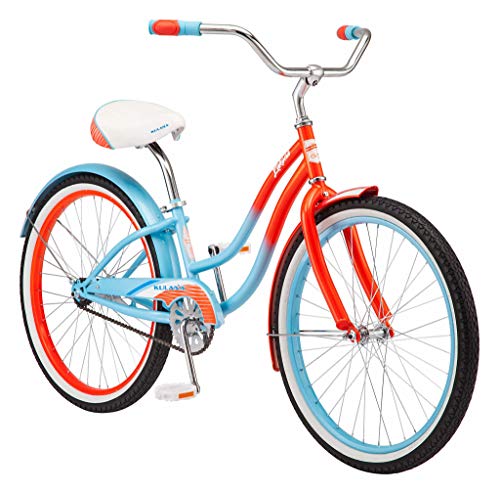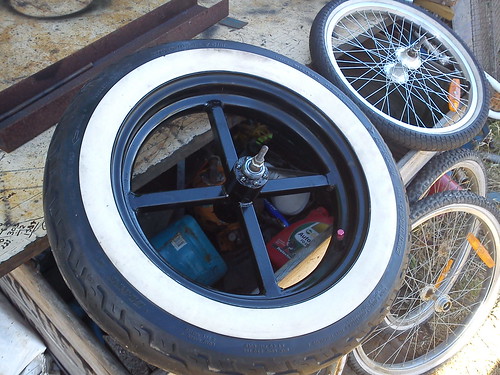I just finished making this rim up for my "Muscle bike build off #01" bike, and thought I would share the process of building a wide freewheel hub. I have noticed many bikes using wider and wider tires and rims, some like the sand and beach bikes would be a good project for a scratch builder if they could get the rims and tires cheap enough, if you build some of these hubs and the following wheel set up and find some used motorbike tires you should be able to do it for next to nothing, depending on what pieces you have available to you of course... The finished hub cost me nothing, I had all the pieces I needed in my bike stockpile, the rim I show later cost me $10 for the car wheels I used to make it, the motorbike tire I will end up using was free from the bike shop, it saves them from paying to dump it. Total cost for the entire wheel, hub and tire combination: $10.
This can even be done without the use of a welder if you are widening by 2 inches or less, if widening by more than that you will probably need a welder to widen the axle anyway. (If you can find the correct endless threaded rod mentioned later, you could theoretically build one as wide as you want without any welding at all.)
If you are not welding and want to spoke this hub to a wider than standard rim, you might want to check "OneHorsePower's" excellent thread on building a wide spoked rim without welding: viewtopic.php?f=3&t=62829
For reference a 16inch motorbike or car tire can be fitted to a wide 20inch bmx style rim for the perfect beach/sand cruiser combination!
To do this you will need some knowledge of how to dismantle and rebuild a standard wheel hub.
First gather your needed parts, The best hub to use for your parts is one that is even across from side to side, you can do it with the dropped centre ones but it will be harder especially if you are building a hub 2+inches wider than standard, I will explain why later.
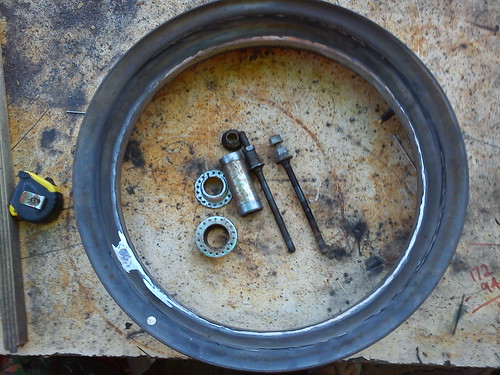
DSC00198 by LukeTheJoker, on Flickr
This photo shows a car rim as well, I will add the process of joining a hub to a car rim later but this first part will work for a normal spoked rim as well so I will keep them seperate.
First thing you want to do is cut your hub in half, then you need to find a piece of tube that fit snugly either inside or outside your hub tube, if you are using a hub similar to mine you may find that a mountain bike seat tube is a perfect fit inside.
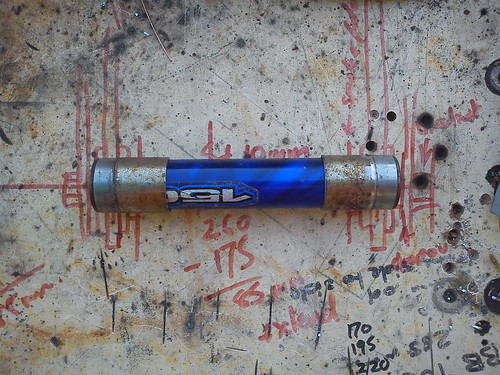
DSC00199 by LukeTheJoker, on Flickr
Cut the tube to the right length to make your hub the width you require, insert your bearing cups if they have been removed before doing this, as they take up some room inside the tube. My hub is going to be 85mm (3+3/8inches) wider than standard.
After trimming to the right length, clean off any paint or powdercoat on the tube you will be welding in, and weld it up! If you are spoking this up to a normal rim, you may not even have to weld it, as the spokes will pull the hub together tightly once they are done up.
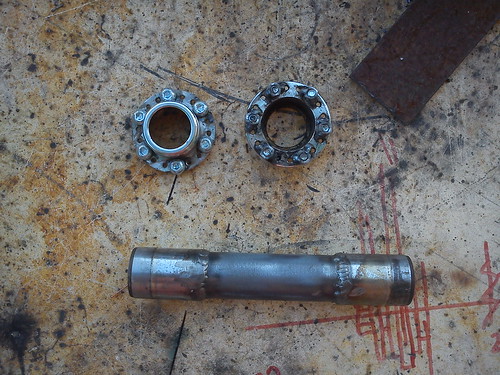
DSC00200 by LukeTheJoker, on Flickr
This photo also shows the two end caps for my hub, they are both drive side threaded endcaps because my bike will be dual drive, they have also been modified to mount brake discs to, you only need to do this if you are running a car wheel, in fact you cant do this if you will be using normal spokes as the brake disc mounts to where the spokes were before, so you can just ignore that if you will be spoking this hub up as normal.
If your hub is going to be 2 inchs (50mm) wider than normal or less, you may find that just using a mountain bike rear axle will give you enough length, they seem to average around 180mm long (just over 7 inchs) If you are going wider than that you will need to lengthen your axles, you can buy 3/8 by 26 thread/inch high tensile endless rod in some places so you may find that easier if you dont trust your welding skills for widening an axle. If you will be widening your own, find two axles that are similar, cut the same amount off each axle to give you your required length, grind the the ends to give you a surface that will allow the weld to penetrate all the way through.
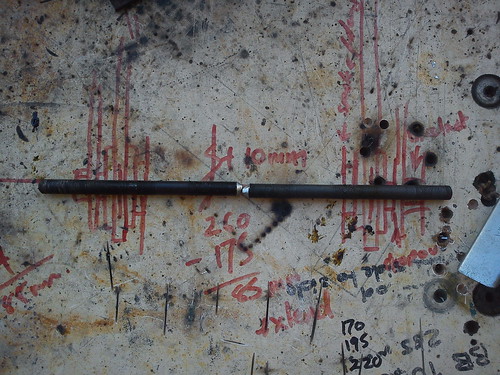
DSC00201 by LukeTheJoker, on Flickr
Weld it up nice and solid, check it for straightness, if it needs straightening now is the time to do it. Then find a 2 inch long section of pipe, tube or even square tube that fits snugly over your axle, grind down your weld to allow it to slip over, being careful not to grind away more than neccesary and weaken the join, slip it on and weld it up!
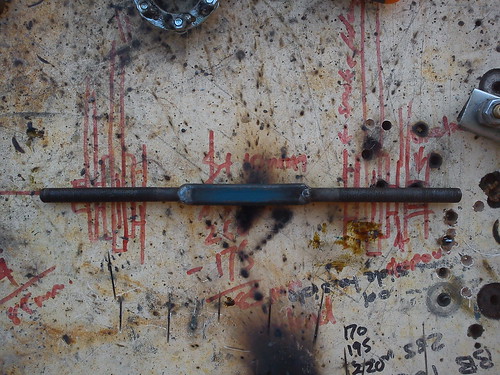
DSC00202 by LukeTheJoker, on Flickr
I have used 1/2inch square tube with 16 guage wall (13x1.6mm) for mine in this picture.
Next step is to fit it all together, if you have widened your axle you will most likely find it no longer fits through the bearing cups in the hub, knock out one side using a drift through the middle, insert the axle and re-install the cup.

DSC00203 by LukeTheJoker, on Flickr
If you are spoking this hub up to a normal rim, your hub is done! If you are using a car rim, keep reading...
This second section is a little more complex, and assumes you have some welding and fabrication knowledge.
If you are planning on welding spokes to a car rim and to your hub, you will find that the centre tube is not strong enough on it's own to support you, you need to brace the tube and also connect the two end caps to stop them coming free of the hub, one solution for doing this is to find a nice piece of fencing pipe the right size to slip over your entire hub, cut it to the right length to just meet both ends and weld it to the end caps, you will end up with something like this...
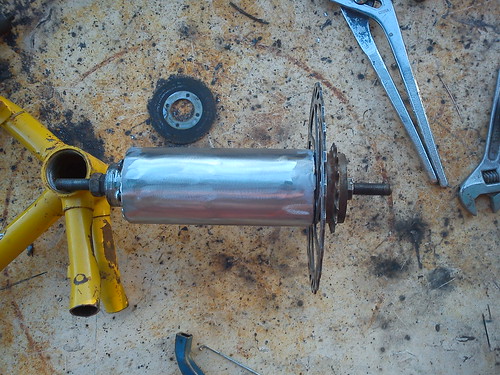
DSC00204 by LukeTheJoker, on Flickr
My hub at this point has the brake disc and freewheel installed on one side, just showing off a little...
Basically now you have a very solid hub that can handle whatever welded spoke design you want to use.
For my hub I decided on four inch by inch (25x25mm) square tube spokes, simply measure the inside diameter of you rim where the spokes will connect and take away from that distance whatever the outside diameter of your hub is. Devide that in two and you have your spoke length. Cut out your spokes! Using welders helper magnet squares or another means, fit your spokes to the hub and weld them on.
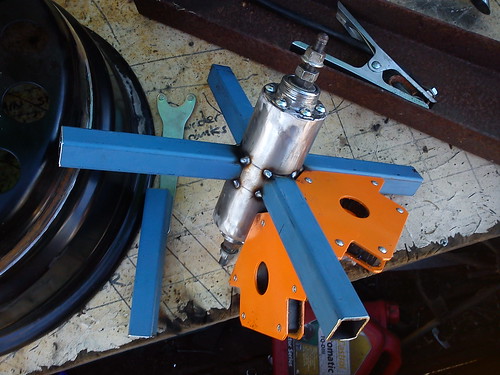
DSC00221 by LukeTheJoker, on Flickr
Now comes the part that is a little bit difficult, you need to find a way to support your rim and the hub/spoke thingy so that they will be perfectly straight when welded, I used a 14inch rim centered underneath to support my 16x3.5inch (made from the narrow side of two 16x5 rims) rimband and propped the spokes up on pieces of flat steel to get them the right height, I could then check that the hub was centered in the rim by comparing it to the hub postioning hole in the bottom rim.
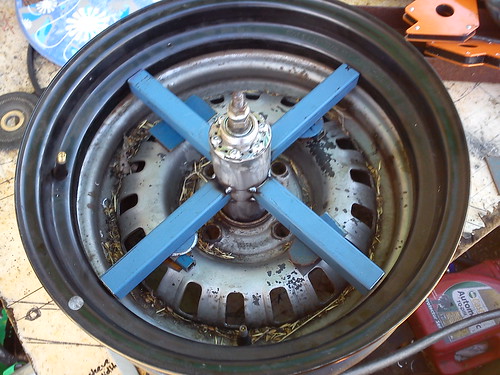
DSC00224 by LukeTheJoker, on Flickr
After tacking every spoke both sides you will want to check you wheel is running true, if it is not you can cut the spoke tacks where the unbalance is and clamp it to the table, clamp it down till you think you have moved it enough and tack it, then recheck if it is running true, if it isn't do the same again.
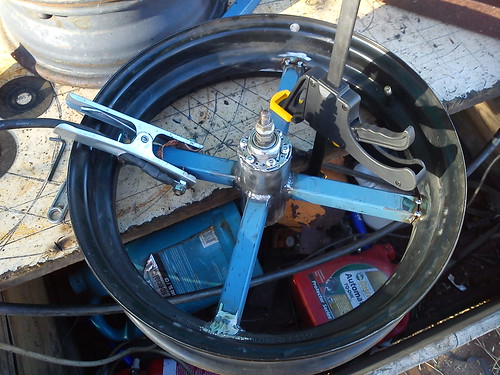
DSC00227 by LukeTheJoker, on Flickr
This bit can take some time, the good thing is you are very unlikely to bend the rim itself, it will only move the hub and spokes.
When you get it straight (or as close as your fast disappearing patience will allow) weld it up and you have your finished extra wide wheel!

DSC00225 by LukeTheJoker, on Flickr
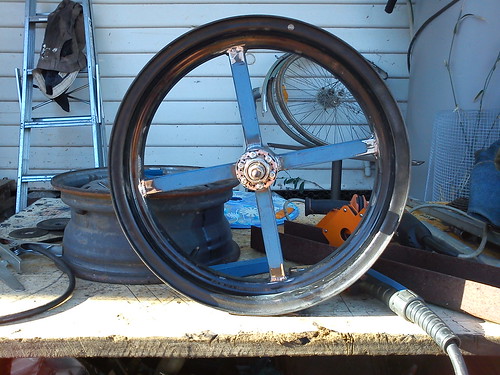
DSC00226 by LukeTheJoker, on Flickr
Get your tire fitted up, (By the way, motorbike tires can be mounted on car rims!) build your frame around it and enjoy the looks everyone will give as you ride past with a huge grin on your face knowing you did it yourself for next to nothing... :mrgreen:
:mrgreen:
If you do make something inspired by this, please post up a pic here so we can all see it...
Luke.
P.S. If you want to know what this looks like on a bike with a tire fitted, you will have to check the "Muscle bike build off" thread when the build is over. viewtopic.php?f=43&t=68143&start=0
UPDATE 18th MAY 2013 RRB BO#8 "BigJim":
Just finished connecting up my monster 245/30/20 shod 20x8 rims to thier spokes and hubs, adding that here in the how to, as they are 8 spokes instead of 4 and I built a jig off the first one so that the second and any future wheels I do will be easier and quicker.
Start the same way with your hub tube, setting up everything with the magnetic clamps for the first spoke.
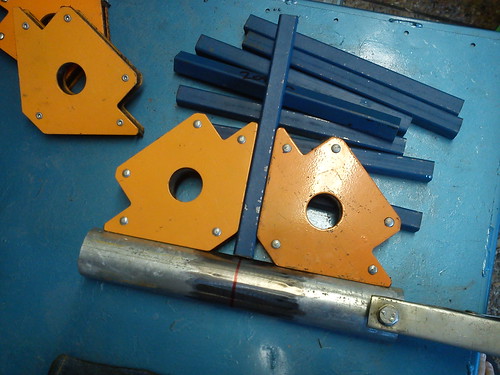
Weld that spoke, position the second spoke at 90 degrees ready for welding.

Weld and continue till you have four spokes, the last one can be checked for angle off two spokes instead of just one, which will tell you if your angles are right or not.
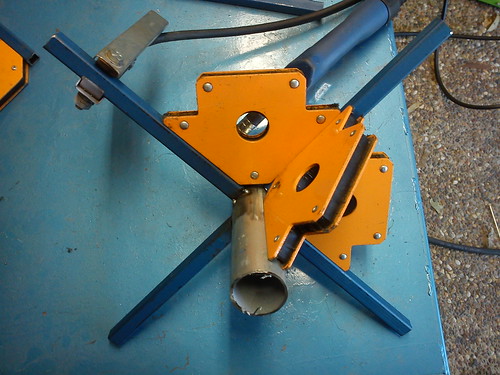
Repeat for the other 4 spokes, except using the 45 degree sides of the magnets.
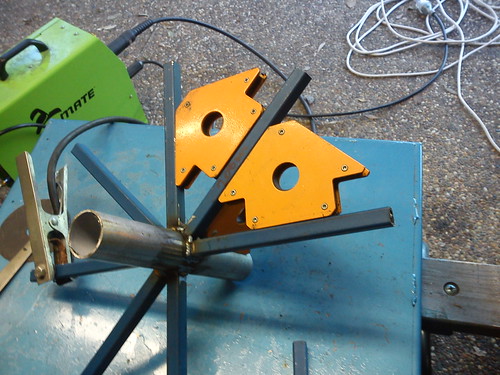
Your finished your 8 spoke wheel spider!
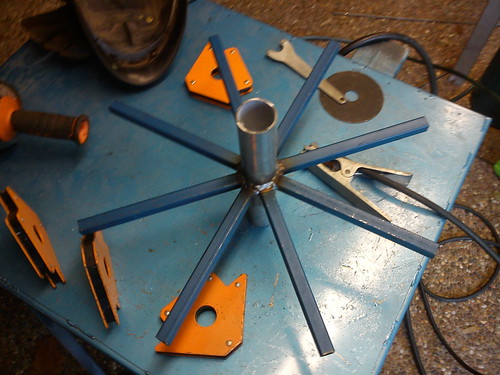
Now to build a jig, using the spider as a guide, so any future wheels are far easier to make. I started with a 13 inch wheel, and added three pieces of steel to decrease the centre hole size to match the tubing I use for my hubs. Make sure you get these central or your wheel may bounce up and down or wobble when done.
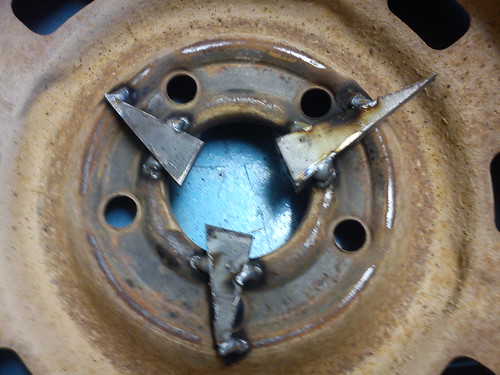
The next step is to build something that holds the back end of the tube, preferably adjustable so you can change the offset of your future rims if you use narrower or wider wheels. Mine is using a motorcycle fork top welded to a simple cross brace made from angle.
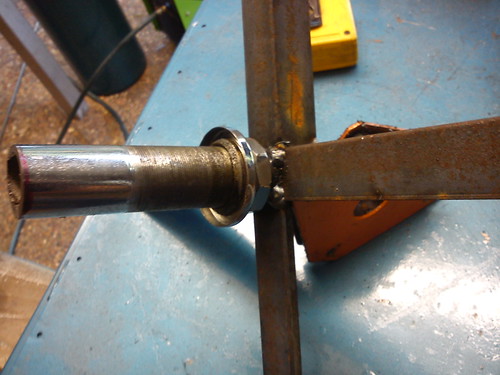
Now, insert your finished 8 spoke spider through the centre hole of your rim, sit the cross brace holding the adjustable offset mechanism on the back of you hub tube and adjust it to fit snug, double check everything is centred and weld the cross brace to the back of the rim.
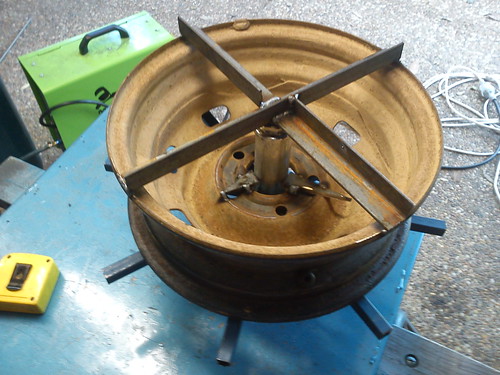
You need to find a way of positioning the spokes so they don't move, on my rim that meant just grinding and filling a notch in the outer rim to hold the outer..
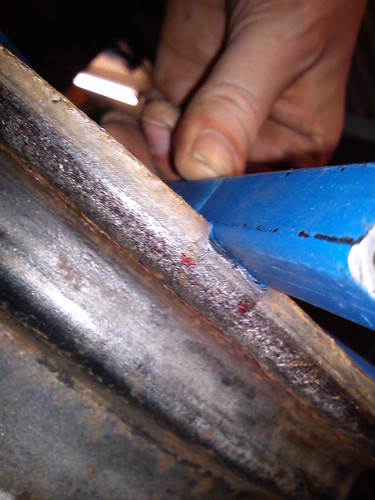
And welding little pieces of round bar closer to the middle to hold the tubes in two spots.
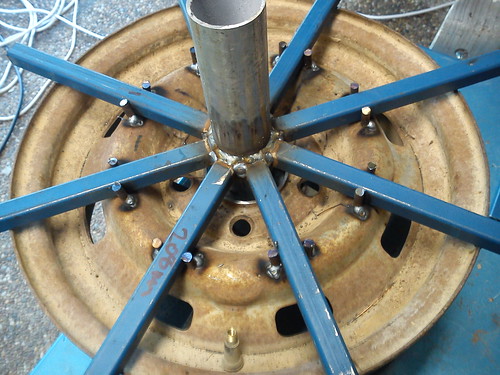
That is the jig finished!
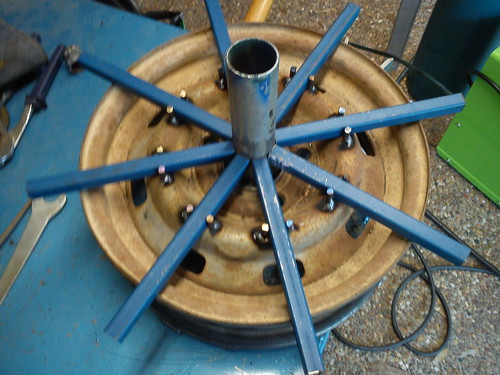
Now to build your second wheel spider if you are doing a bike with front and rear fat wheels, simply lay the spokes in the slots, slide the hub tube in and start tacking, once it is fully tacked on one side, slide it out and flip it over to fully weld it. I found the first wheel spider takes about an hour to build precisely, future ones built off the jig take only 15 minutes...
Once you have your spiders welded, you need to work out the positioning on your rims, by propping them up on bits of wood or steel till the spokes sit in the centre of the rim. (Note the line marked inside the rim to help with this.)
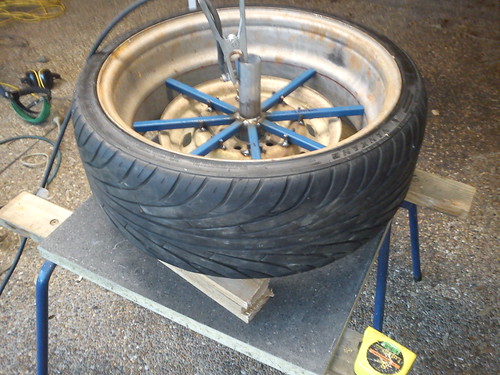
Weld it up, repeat for any other wheels you are using and it is done!
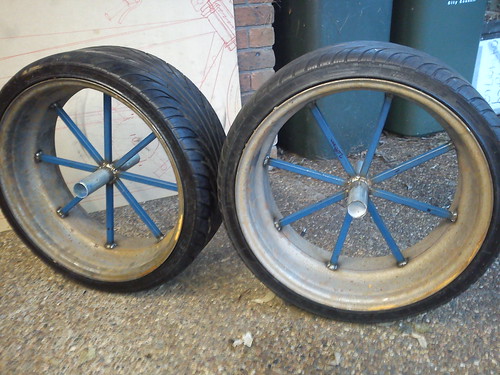
You can see at this point I have not yet added the bearing cups and axles to the wheels, but the method for that will be the same as the method described at the start of this "How To"
Here is a link to the build these will be used on: viewtopic.php?f=76&t=72017#p696728
UPDATE 2: MBBO#3 "Mad Maxine"
Tried something different for the next set, modified the jig for 5 spoke centres and used 12 and 18" dirt bike rims and tires with old steel bike rims welded inside to cover the spoke hole and dimples:
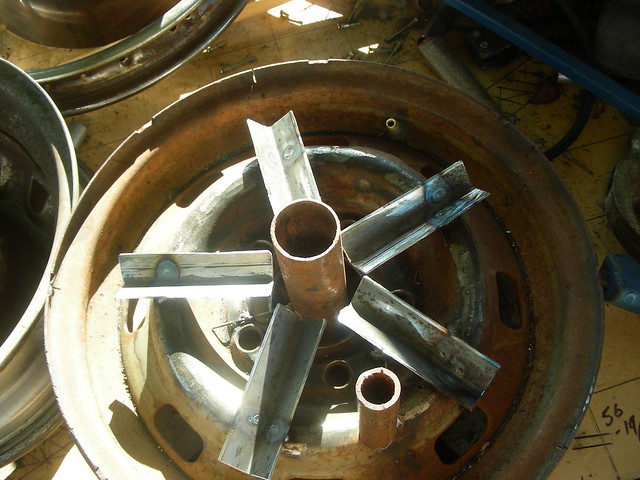
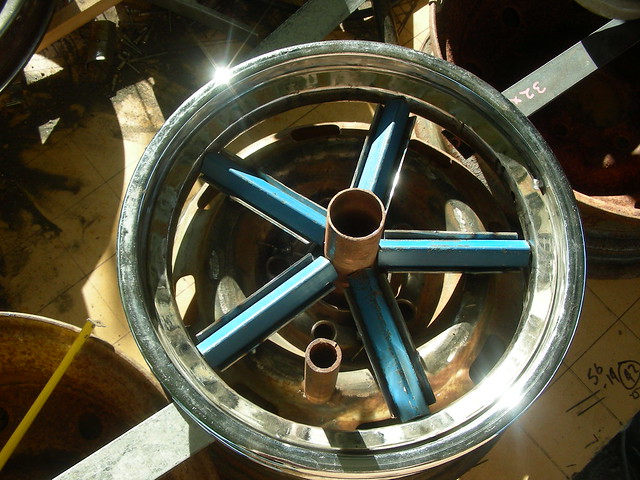
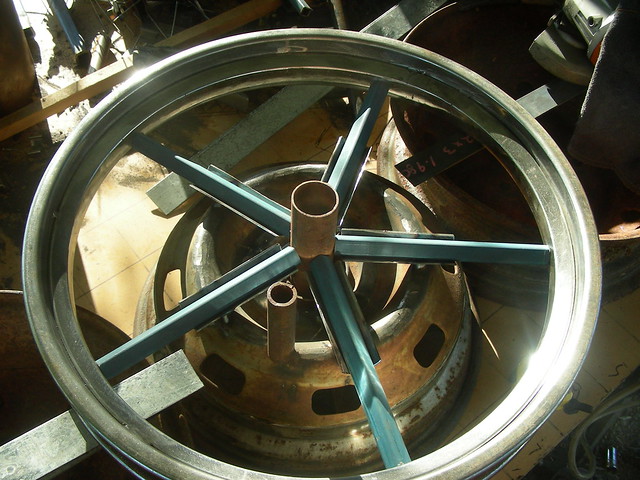

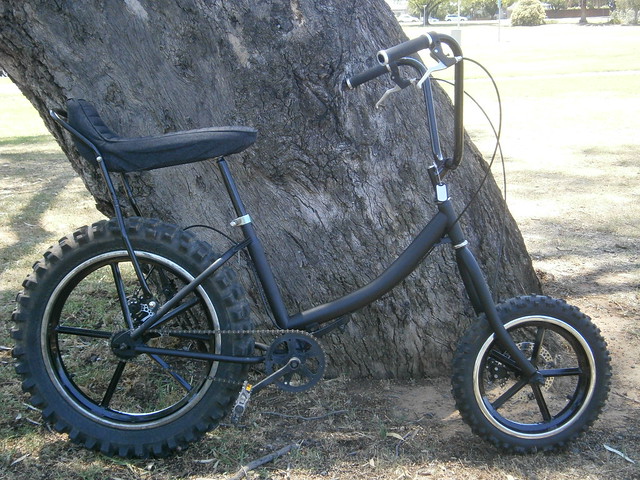
UPDATE 3: "PEDRO" MBBO#04. Sep 2015:
I have now done some wheels that are not just straight spokes!
Complete details can be found in this thread:
http://www.ratrodbikes.com/forum/index.php?threads/mbbo-04-class-2-lambo-pedro-plans-revealed.94236/
Here are some pics:
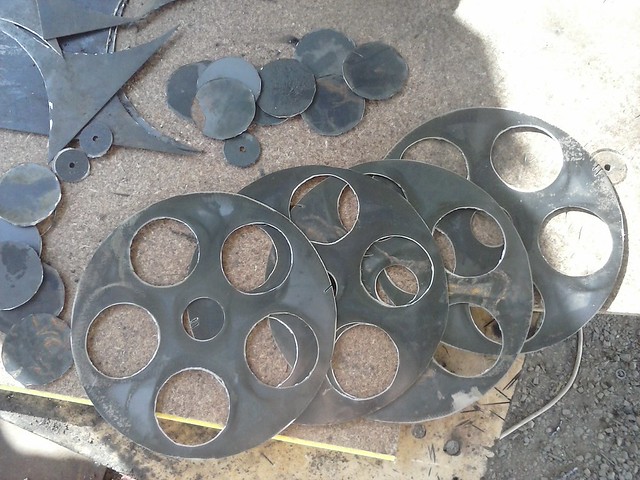
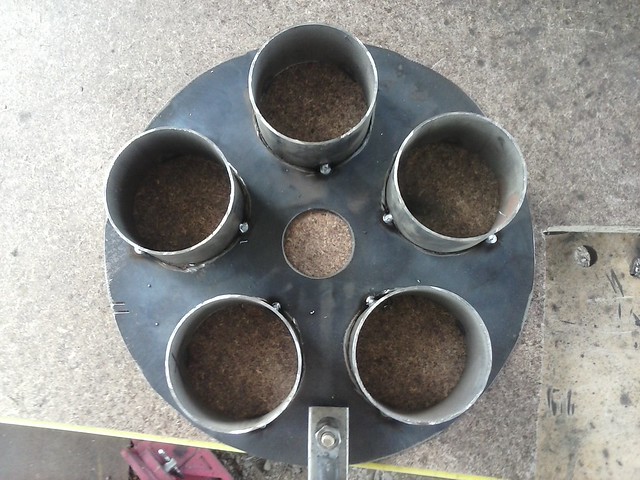

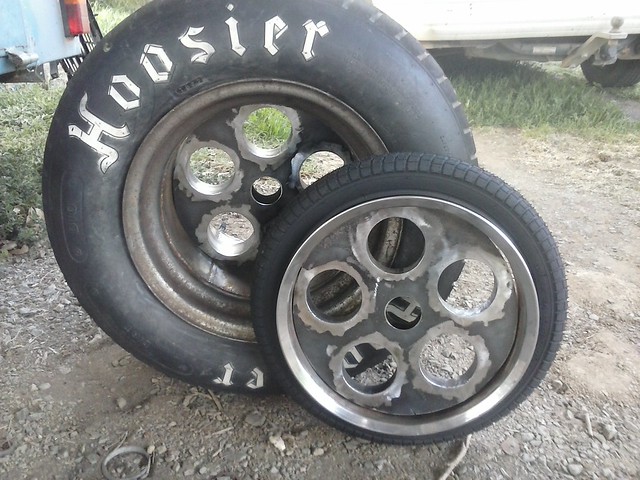
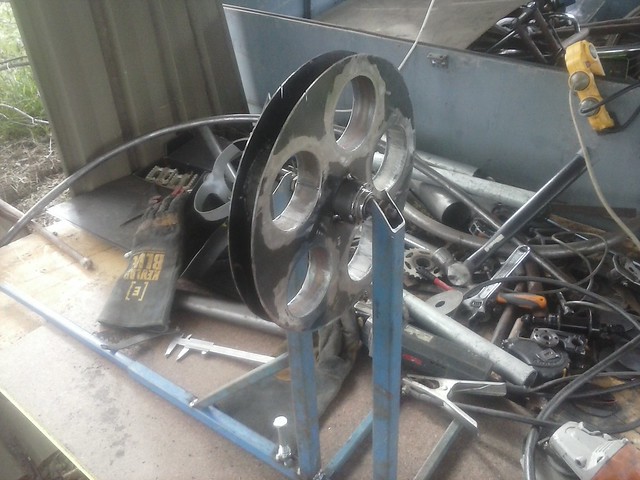
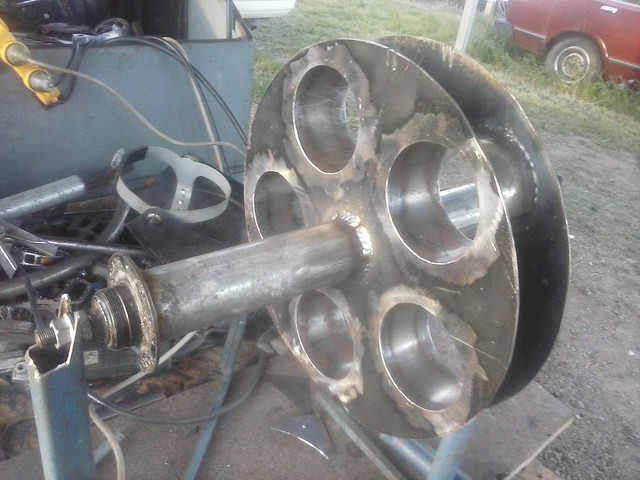
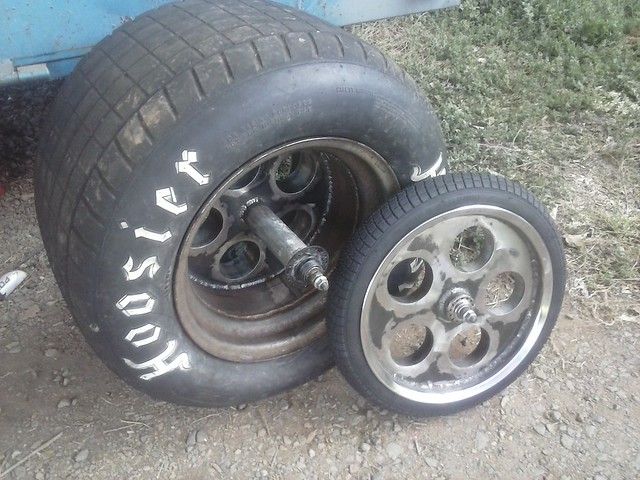
Hubs are built the same way, but two pieces of 16 gauge steel and some 3" exhaust tube make up the wheel centres...
Feel free to ask any questions you want or pm me for more information.
Luke.
This can even be done without the use of a welder if you are widening by 2 inches or less, if widening by more than that you will probably need a welder to widen the axle anyway. (If you can find the correct endless threaded rod mentioned later, you could theoretically build one as wide as you want without any welding at all.)
If you are not welding and want to spoke this hub to a wider than standard rim, you might want to check "OneHorsePower's" excellent thread on building a wide spoked rim without welding: viewtopic.php?f=3&t=62829
For reference a 16inch motorbike or car tire can be fitted to a wide 20inch bmx style rim for the perfect beach/sand cruiser combination!
To do this you will need some knowledge of how to dismantle and rebuild a standard wheel hub.
First gather your needed parts, The best hub to use for your parts is one that is even across from side to side, you can do it with the dropped centre ones but it will be harder especially if you are building a hub 2+inches wider than standard, I will explain why later.

DSC00198 by LukeTheJoker, on Flickr
This photo shows a car rim as well, I will add the process of joining a hub to a car rim later but this first part will work for a normal spoked rim as well so I will keep them seperate.
First thing you want to do is cut your hub in half, then you need to find a piece of tube that fit snugly either inside or outside your hub tube, if you are using a hub similar to mine you may find that a mountain bike seat tube is a perfect fit inside.

DSC00199 by LukeTheJoker, on Flickr
Cut the tube to the right length to make your hub the width you require, insert your bearing cups if they have been removed before doing this, as they take up some room inside the tube. My hub is going to be 85mm (3+3/8inches) wider than standard.
After trimming to the right length, clean off any paint or powdercoat on the tube you will be welding in, and weld it up! If you are spoking this up to a normal rim, you may not even have to weld it, as the spokes will pull the hub together tightly once they are done up.

DSC00200 by LukeTheJoker, on Flickr
This photo also shows the two end caps for my hub, they are both drive side threaded endcaps because my bike will be dual drive, they have also been modified to mount brake discs to, you only need to do this if you are running a car wheel, in fact you cant do this if you will be using normal spokes as the brake disc mounts to where the spokes were before, so you can just ignore that if you will be spoking this hub up as normal.
If your hub is going to be 2 inchs (50mm) wider than normal or less, you may find that just using a mountain bike rear axle will give you enough length, they seem to average around 180mm long (just over 7 inchs) If you are going wider than that you will need to lengthen your axles, you can buy 3/8 by 26 thread/inch high tensile endless rod in some places so you may find that easier if you dont trust your welding skills for widening an axle. If you will be widening your own, find two axles that are similar, cut the same amount off each axle to give you your required length, grind the the ends to give you a surface that will allow the weld to penetrate all the way through.

DSC00201 by LukeTheJoker, on Flickr
Weld it up nice and solid, check it for straightness, if it needs straightening now is the time to do it. Then find a 2 inch long section of pipe, tube or even square tube that fits snugly over your axle, grind down your weld to allow it to slip over, being careful not to grind away more than neccesary and weaken the join, slip it on and weld it up!

DSC00202 by LukeTheJoker, on Flickr
I have used 1/2inch square tube with 16 guage wall (13x1.6mm) for mine in this picture.
Next step is to fit it all together, if you have widened your axle you will most likely find it no longer fits through the bearing cups in the hub, knock out one side using a drift through the middle, insert the axle and re-install the cup.

DSC00203 by LukeTheJoker, on Flickr
If you are spoking this hub up to a normal rim, your hub is done! If you are using a car rim, keep reading...
This second section is a little more complex, and assumes you have some welding and fabrication knowledge.
If you are planning on welding spokes to a car rim and to your hub, you will find that the centre tube is not strong enough on it's own to support you, you need to brace the tube and also connect the two end caps to stop them coming free of the hub, one solution for doing this is to find a nice piece of fencing pipe the right size to slip over your entire hub, cut it to the right length to just meet both ends and weld it to the end caps, you will end up with something like this...

DSC00204 by LukeTheJoker, on Flickr
My hub at this point has the brake disc and freewheel installed on one side, just showing off a little...
Basically now you have a very solid hub that can handle whatever welded spoke design you want to use.
For my hub I decided on four inch by inch (25x25mm) square tube spokes, simply measure the inside diameter of you rim where the spokes will connect and take away from that distance whatever the outside diameter of your hub is. Devide that in two and you have your spoke length. Cut out your spokes! Using welders helper magnet squares or another means, fit your spokes to the hub and weld them on.

DSC00221 by LukeTheJoker, on Flickr
Now comes the part that is a little bit difficult, you need to find a way to support your rim and the hub/spoke thingy so that they will be perfectly straight when welded, I used a 14inch rim centered underneath to support my 16x3.5inch (made from the narrow side of two 16x5 rims) rimband and propped the spokes up on pieces of flat steel to get them the right height, I could then check that the hub was centered in the rim by comparing it to the hub postioning hole in the bottom rim.

DSC00224 by LukeTheJoker, on Flickr
After tacking every spoke both sides you will want to check you wheel is running true, if it is not you can cut the spoke tacks where the unbalance is and clamp it to the table, clamp it down till you think you have moved it enough and tack it, then recheck if it is running true, if it isn't do the same again.

DSC00227 by LukeTheJoker, on Flickr
This bit can take some time, the good thing is you are very unlikely to bend the rim itself, it will only move the hub and spokes.
When you get it straight (or as close as your fast disappearing patience will allow) weld it up and you have your finished extra wide wheel!

DSC00225 by LukeTheJoker, on Flickr

DSC00226 by LukeTheJoker, on Flickr
Get your tire fitted up, (By the way, motorbike tires can be mounted on car rims!) build your frame around it and enjoy the looks everyone will give as you ride past with a huge grin on your face knowing you did it yourself for next to nothing...
If you do make something inspired by this, please post up a pic here so we can all see it...
Luke.
P.S. If you want to know what this looks like on a bike with a tire fitted, you will have to check the "Muscle bike build off" thread when the build is over. viewtopic.php?f=43&t=68143&start=0
UPDATE 18th MAY 2013 RRB BO#8 "BigJim":
Just finished connecting up my monster 245/30/20 shod 20x8 rims to thier spokes and hubs, adding that here in the how to, as they are 8 spokes instead of 4 and I built a jig off the first one so that the second and any future wheels I do will be easier and quicker.
Start the same way with your hub tube, setting up everything with the magnetic clamps for the first spoke.

Weld that spoke, position the second spoke at 90 degrees ready for welding.

Weld and continue till you have four spokes, the last one can be checked for angle off two spokes instead of just one, which will tell you if your angles are right or not.

Repeat for the other 4 spokes, except using the 45 degree sides of the magnets.

Your finished your 8 spoke wheel spider!

Now to build a jig, using the spider as a guide, so any future wheels are far easier to make. I started with a 13 inch wheel, and added three pieces of steel to decrease the centre hole size to match the tubing I use for my hubs. Make sure you get these central or your wheel may bounce up and down or wobble when done.

The next step is to build something that holds the back end of the tube, preferably adjustable so you can change the offset of your future rims if you use narrower or wider wheels. Mine is using a motorcycle fork top welded to a simple cross brace made from angle.

Now, insert your finished 8 spoke spider through the centre hole of your rim, sit the cross brace holding the adjustable offset mechanism on the back of you hub tube and adjust it to fit snug, double check everything is centred and weld the cross brace to the back of the rim.

You need to find a way of positioning the spokes so they don't move, on my rim that meant just grinding and filling a notch in the outer rim to hold the outer..

And welding little pieces of round bar closer to the middle to hold the tubes in two spots.

That is the jig finished!

Now to build your second wheel spider if you are doing a bike with front and rear fat wheels, simply lay the spokes in the slots, slide the hub tube in and start tacking, once it is fully tacked on one side, slide it out and flip it over to fully weld it. I found the first wheel spider takes about an hour to build precisely, future ones built off the jig take only 15 minutes...
Once you have your spiders welded, you need to work out the positioning on your rims, by propping them up on bits of wood or steel till the spokes sit in the centre of the rim. (Note the line marked inside the rim to help with this.)

Weld it up, repeat for any other wheels you are using and it is done!

You can see at this point I have not yet added the bearing cups and axles to the wheels, but the method for that will be the same as the method described at the start of this "How To"
Here is a link to the build these will be used on: viewtopic.php?f=76&t=72017#p696728
UPDATE 2: MBBO#3 "Mad Maxine"
Tried something different for the next set, modified the jig for 5 spoke centres and used 12 and 18" dirt bike rims and tires with old steel bike rims welded inside to cover the spoke hole and dimples:





UPDATE 3: "PEDRO" MBBO#04. Sep 2015:
I have now done some wheels that are not just straight spokes!
Complete details can be found in this thread:
http://www.ratrodbikes.com/forum/index.php?threads/mbbo-04-class-2-lambo-pedro-plans-revealed.94236/
Here are some pics:







Hubs are built the same way, but two pieces of 16 gauge steel and some 3" exhaust tube make up the wheel centres...
Feel free to ask any questions you want or pm me for more information.
Luke.
Last edited:









